 LA VITA NUOVA DANTE ALIGHIERI was born in Florence in 1265 and belonged to a noble but impoverished family. He followed a normal course of studies, possibly attending university in Bologna, and when he was about twenty he married Gemma Donati, by whom he had three children. He had first met Bice Portinari, whom he called Beatrice, in 1274, and when she died in 1290 he sought distraction by studying philosophy and theology and by writing the Vita Nuova. During this time he became involved in the strife between the Guelfs and the Ghibellines; he became a prominent White Guelf and when the Black Guelfs came to power in 1302 Dante, during an absence from Florence, was condemned to exile. He took refuge first in Verona and after wandering from place to place, possibly to Paris and even, some have said improbably, to Oxford, he settled in Ravenna. While there he completed The Divine Comedy, which he had begun in about 1308, if not later. Dante died in Ravenna in 1321.
LA VITA NUOVA DANTE ALIGHIERI was born in Florence in 1265 and belonged to a noble but impoverished family. He followed a normal course of studies, possibly attending university in Bologna, and when he was about twenty he married Gemma Donati, by whom he had three children. He had first met Bice Portinari, whom he called Beatrice, in 1274, and when she died in 1290 he sought distraction by studying philosophy and theology and by writing the Vita Nuova. During this time he became involved in the strife between the Guelfs and the Ghibellines; he became a prominent White Guelf and when the Black Guelfs came to power in 1302 Dante, during an absence from Florence, was condemned to exile. He took refuge first in Verona and after wandering from place to place, possibly to Paris and even, some have said improbably, to Oxford, he settled in Ravenna. While there he completed The Divine Comedy, which he had begun in about 1308, if not later. Dante died in Ravenna in 1321.
BARBARA REYNOLDS was for twenty-two years Lecturer in Italian at Cambridge University and subsequently Reader in Italian Studies at Nottingham University. Her first book was a textual reconstruction of the linguistic writings of Alessandro Manzoni. The General Editor of the Cambridge Italian Dictionary, she was created Cavaliere Ufficiale al Merito della Repubblica Italiana in 1978. She has been awarded silver medals by the Italian Government and by the Province of Vicenza and the Edmund Gardner Prize for her services to Italian scholarship. She has been Visiting Professor at the University of California, Berkeley, at Wheaton College, Illinois, at Hope College, Michigan, and at Trinity College, Dublin. She has translated Dantes Paradiso,left unfinished by Dorothy L.
Sayers on her death in 1957, and Ariostos Orlando Furiosofor the Penguin Classics. She is the author of The Passionate Intellect: Dorothy L. Sayers Encounter with Dante and Dorothy L. Sayers: Her Life and Soul. She is also the editor of The Letters of Dorothy L. Sayers. She holds three Honorary Doctorates and is the managing editor of SEVEN: An Anglo-American Literary Review.DANTE ALIGHIERI
La Vita Nuova
(Poems of Youth)
Translated with an Introduction by BARBARA REYNOLDS REVISED EDITION PENGUIN BOOKS PENGUIN BOOKS Published by the Penguin Group Penguin Books Ltd, 80 Strand, London WC2R 0RL, England Penguin Group (USA) Inc., 375 Hudson Street, New York, New York 10014, USA Penguin Books Australia Ltd, 250 Camberwell Road, Camberwell, Victoria 312.4, Australia Penguin Books Canada Ltd, 10 Alcorn Avenue, Toronto, Ontario, Canada M4V 3B2 Penguin Books India (P) Ltd, 11 Community Centre, Panchsheel Park, New Delhi 110 017, India Penguin Books (NZ) Ltd, Cnr Rosedale and Airborne Roads, Albany, Auckland, New Zealand Penguin Books (South Africa) (Pty) Ltd, 24 Sturdee Avenue, Rosebank 2196, South Africa Penguin Books Ltd, Registered Offices: 80 Strand, London WC2R 0RL, England www.penguin.com This translation first published 1969 Revised edition, 2004 Copyright Barbara Reynolds, 1969, 2004 All rights reserved Except in the United States of America, this book is sold subject to the condition that it shall not, by way of trade or otherwise, be lent, re-sold, hired out, or otherwise circulated without the publishers prior consent in any form of binding or cover other than that in which it is published and without a similar condition including this condition being imposed on the subsequent purchaser EISBN: 9780141907345
Contents
Foreword to the Revised Edition
Over thirty years have passed since my translation of the
Vita Nuova was first published by Penguin Classics in 1969. It has been reprinted many times and has met with a measure of acceptance.
Since then I have altered some of my views on the work and in the course of writing a biography of Dante I have made one or two discoveries. I have accordingly provided a new Introduction and made a few adjustments to the Notes. There are also some alterations to the verse. Cambridge, 2003
Chronology
(From the birth of Dante to his entry into political life) 1265 between 21 May and 21 June: Birth of Dante. 1266 January: Birth of Beatrice. 128082 Dante composes and circulates his earliest sonnets. 1283 1 May: Second meeting of Dante and Beatrice. 1283 1 May: Second meeting of Dante and Beatrice.
MayJune: Dantes father has died by this date and Dante comes of age, at eighteen, as an orphan, according to the laws of Florence. MayJune?: Dante composes and circulates a sonnet describing a dream (the first sonnet in La Vita Nuova). Meeting with Guido Cavalcanti and beginning of their friendship. Dante affects love for the first screen-lady. 1284 Dante composes a serventese containing the names of the sixty most beautiful women in Florence. 1285 Autumn: Death of a friend of Beatrice. 1285 Autumn: Death of a friend of Beatrice.
October: Dante takes part in cavalry expedition of Florentine militia in support of Tuscan Guelfs against the Castle of Poggio di Santa Cecilia, which, roused to rebellion by the Ghibellines of Arezzo, surrendered in April 1286. 1286 AprilMay?: Dante pays court to the second screen-love. Beatrice snubs him. (1289 11 June: Dante takes part in the Battle of Campaldino against the Ghibellines of Arezzo. August: Dante takes part in the siege of Caprona, near Pisa.) 1289 31 December: Death of Beatrices father, Folco dei Portinari. 8 June: Death of Beatrice. 8 June: Death of Beatrice.
Summer: Visit to Dante of Beatrices brother. 1291 8 June: First anniversary of death of Beatrice; some men of importance visit Dante as he draws figures of angels. 1292? Dante first sees the compassionate young woman (the donna gentile) looking at him from a window. 1293? Vision of Beatrice as a child. 1293 Easter?: Pilgrims pass through Florence on their way to Rome. (1294? Composition of La Vita Nuova. 1295 Dante enters political life.)
Introduction
The
Vita Nuova is a treatise by a poet, written for poets, on the art of poetry. (1294? Composition of
La Vita Nuova. 1295 Dante enters political life.)
Introduction
The
Vita Nuova is a treatise by a poet, written for poets, on the art of poetry.
It consists of a selection of Dantes early poems a selection he made himself combined with his own prose commentary. The commentary is of two kinds. First, Dante narrates the events and emotions which led him to compose each poem; then, unless he considers that the meaning has already been made sufficiently clear, he analyses the relationship of the content to the structure. The majority of the poems are directly concerned with Dantes love for Beatrice, and all of them have some bearing on this theme. He does not divulge her family name but she has been identified with Beatrice, the daughter of a prominent Florentine citizen, Folco dei Portinari. She was one of eleven children, five sons and six daughters.
One of her brothers was a close friend of Dante. Folco dei Portinari held government office and was elected Prior of Florence in August 1282. In 1288 he founded the Hospital of Santa Maria Nuova. In his will, dated 15 January 1288, it is shown that Beatrice, to whom he bequeathed fifty Florentine pounds, was by then married to Simone dei Bardi, a member of a prominent family of bankers. She died in 1290, aged twenty-four. A few years later, possibly between 1292 and 1294, when he was in his late twenties, perhaps in an attempt to recover from his grief, Dante assembled his poems and wrote his commentaries.
The title, translated literally, means New Life, but it is not certain that Dante originally intended it to be the title of the whole work. It arises from the Latin words
Next page

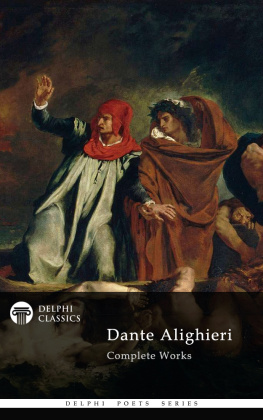

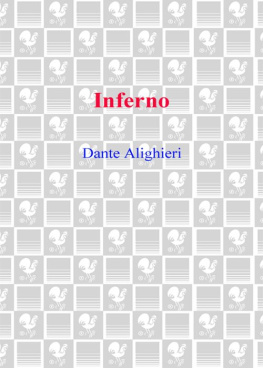

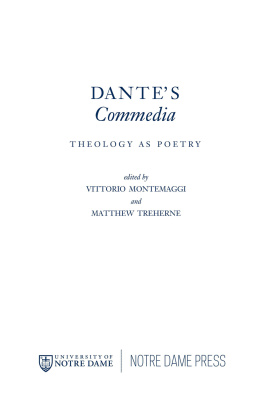
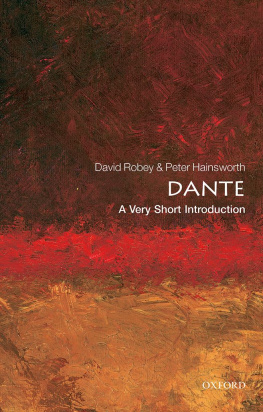
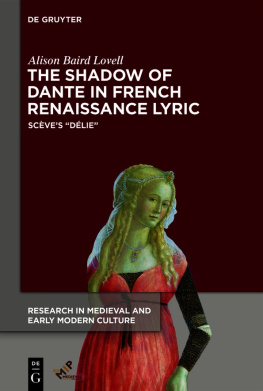
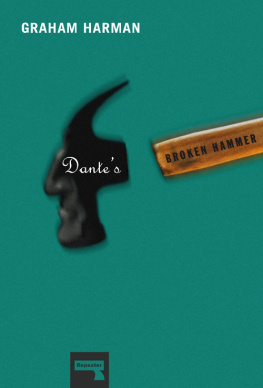
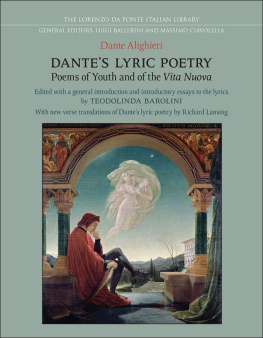

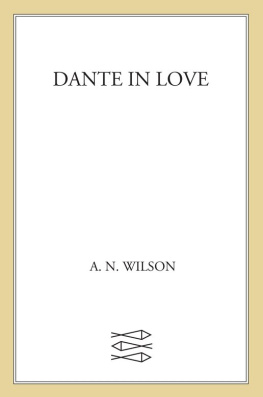
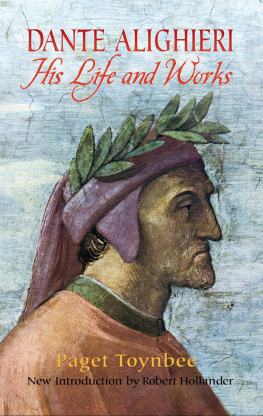
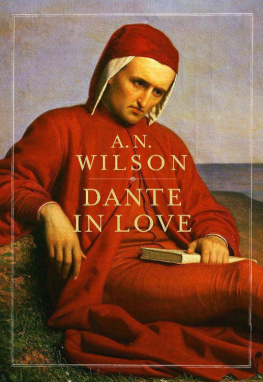
 LA VITA NUOVA DANTE ALIGHIERI was born in Florence in 1265 and belonged to a noble but impoverished family. He followed a normal course of studies, possibly attending university in Bologna, and when he was about twenty he married Gemma Donati, by whom he had three children. He had first met Bice Portinari, whom he called Beatrice, in 1274, and when she died in 1290 he sought distraction by studying philosophy and theology and by writing the Vita Nuova. During this time he became involved in the strife between the Guelfs and the Ghibellines; he became a prominent White Guelf and when the Black Guelfs came to power in 1302 Dante, during an absence from Florence, was condemned to exile. He took refuge first in Verona and after wandering from place to place, possibly to Paris and even, some have said improbably, to Oxford, he settled in Ravenna. While there he completed The Divine Comedy, which he had begun in about 1308, if not later. Dante died in Ravenna in 1321.
LA VITA NUOVA DANTE ALIGHIERI was born in Florence in 1265 and belonged to a noble but impoverished family. He followed a normal course of studies, possibly attending university in Bologna, and when he was about twenty he married Gemma Donati, by whom he had three children. He had first met Bice Portinari, whom he called Beatrice, in 1274, and when she died in 1290 he sought distraction by studying philosophy and theology and by writing the Vita Nuova. During this time he became involved in the strife between the Guelfs and the Ghibellines; he became a prominent White Guelf and when the Black Guelfs came to power in 1302 Dante, during an absence from Florence, was condemned to exile. He took refuge first in Verona and after wandering from place to place, possibly to Paris and even, some have said improbably, to Oxford, he settled in Ravenna. While there he completed The Divine Comedy, which he had begun in about 1308, if not later. Dante died in Ravenna in 1321.